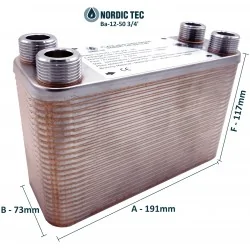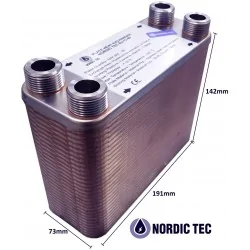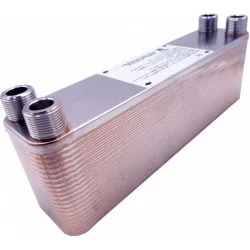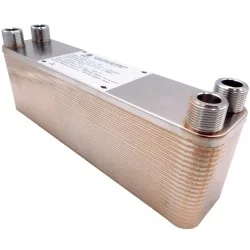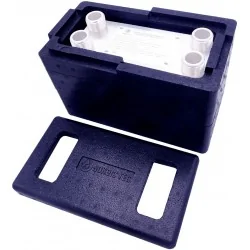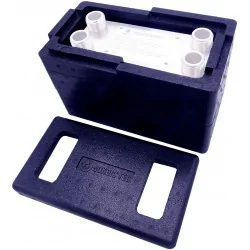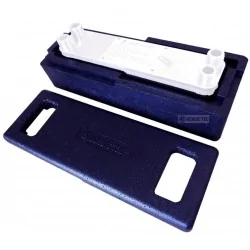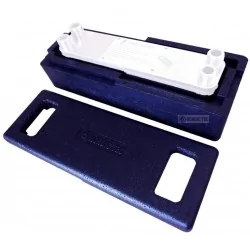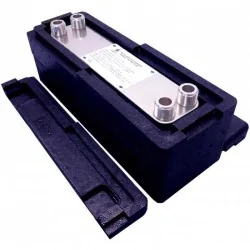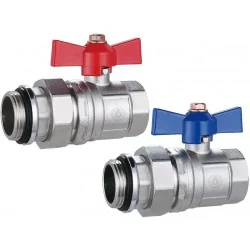Campervan Hot Water Heat Exchangers
Heat Exchangers | Hot Water Heaters for Campervans & Motorhomes by Nordic Tec
In this category, we present heat exchangers that have been specifically selected for their technical properties to efficiently heat hot water in a campervan or motorhome. Nowadays, caravanning no longer means going without hot water – a heat exchanger in function of a campervan hot water heater makes this comfort possible even in a camper by utilizing the heating energy generated by the vehicle.
Nordic Tec’s heat exchangers for campers feature a plate surface starting from 0.60 m², as we consider this size optimal. These heat exchangers are powerful enough to supply hot water within a short time – assuming the motorhome’s heating system is used as the heat source. At the same time, they are compact and relatively lightweight, which is another advantage for use in caravanning.
Our recommendation for a classic campervan or motorhome is a heat exchanger with a surface area of at least 0.6 m².
However, if you want maximum comfort and wish to minimize the heating time for hot water as much as possible, you should consider using a larger heat exchanger with a surface area of over 1 m².
Choosing a Heat Exchanger for a Camper | Campervan hot water heater by Nordic Tec
Nordic Tec believes that heat exchangers for campers to be useful as hot water heaters should have a minimum plate area of 0.6 m² to ensure relatively fast water heating – optimally, slightly more. The larger the plate area, the faster the water heats up and the more efficient the recovery of energy generated by the engine. Therefore, for the sake of comfort – and perhaps the environment – it’s worth considering purchasing a heat exchanger with an area of 1 to 1.2 m².
Larger heat exchangers with over 1.2 m² generally offer no additional benefit when heating water in a campervan or at a campsite. Life in a motorhome certainly doesn’t have to mean sacrificing basic comfort.
Which Type of Heat Exchanger Is Best for a Campervan?
There are many types of heat exchangers on the market, and in principle, any of them could be used for water heating in a motorhome. However, the key is to find the optimal compromise between price, durability, and cleaning effort.
Additionally, it’s important that the heat exchanger isn’t too large but rather compact and lightweight. For this reason, we advise against carrying bulky shell-and-tube heat exchangers in a campervan and instead recommend using compact plate heat exchangers (plate heat exchangers).
Connection Size of Heat Exchangers for Motorhomes
For this specific application, a connection size of 3/4" is considered standard and entirely sufficient. Given the flow rates in a typical hot water system for camping, there’s usually no need to look for a heat exchanger with 1" connections – which is why we don’t offer such models in this category.
A 1" connection could even be problematic, as it would require reducers and additional adapters. When selecting a heat exchanger for a motorhome, it’s best to simply check what you actually need.
Heat Exchanger Material – and Suitability for Water Heating in Motorhoming
It’s important to note that heat exchangers for hot water in motorhoming should not be made of standard stainless steel (S304). Instead, stainless steel S316 is used – for several reasons:
First, the water used during travel isn’t always of good quality. It’s often hard and minimally or not at all treated (e.g., from rural sources). Repeated use of such water requires higher-quality materials to ensure the device’s longevity.
Second, there are drinking water standards – stainless steel 316L is also approved for contact with potable water. This isn’t just about regulations (which are rarely enforced anyway) but about our health: stainless steel S316L provides a less favorable environment for bacterial growth.
Of course, regular maintenance is still necessary – after stationary use, a brief flush of the heat exchanger for a few minutes is recommended.
How Much Does a Heat Exchanger for a Motorhome Cost?
Generally, heat exchangers for motorhomes aren’t among the most expensive devices on the market, as this application doesn’t require large models. While a heat exchanger for a larger single-family home can cost around €300, high-quality models for motorhomes are available starting at €100–110.
Additional Features – Are They Necessary?
Of course, there are various accessories that can simplify installation or improve a heat exchanger’s efficiency – such as systems with heat pumps.
For motorhomes, the only consideration might be thermal insulation, which is purely optional and not strictly necessary. Its purpose is to reduce heat loss – ensuring the heat exchanger releases as little energy as possible to the surroundings, so more heat can be used for water heating. This can help shorten the warm-up time of the water tank and save some fuel in the motorhome over time.
An unexpected benefit of insulation when using a heat exchanger in a camper or at a campsite is device protection: if the heat exchanger falls from a height, the foam insulation can prevent dents or minor damage.

